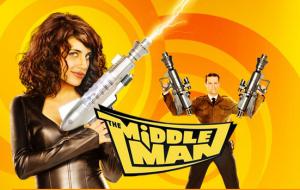 On paper The Middleman sounds like an amazing show: young struggling artist and gamer girl gets recruited by mysterious crime-fighting agency to battle comic book-style villains. (So many words to love in that sentence.)
On paper The Middleman sounds like an amazing show: young struggling artist and gamer girl gets recruited by mysterious crime-fighting agency to battle comic book-style villains. (So many words to love in that sentence.)
It’s based on a graphic novel by Javier Grillo-Marxuach and Les McClaine, and the production style echoes that origin. It’s got a Scott Pilgrim thing going on, but its tone also reminds me of Wonderfalls or Pushing Daisies. Yet, it only takes about five minutes of the pilot to notice that this show is terrible. That could be why it only lasted 12 episodes in 2008, but then, better shows have lasted even less (e.g. the aforementioned Wonderfalls). And, for all I know, there is a die-hard Middleman fan base out there cranking out fan fiction and tweeting to the network to revive it. So what’s wrong with it?
First of all, it was on ABC Family. ABC Family seems to think it has an audience for campy genre TV (Three Moons Over Milford) yet only succeeds with teen soap operas (Secret Life, Pretty Little Liars). They also tend to keep things in a safe-for-family-viewing zone that doesn’t necessarily work for genre TV.
Middleman banks on its audience’s existing knowledge of comics, gaming, sci-fi, and action movies. It packs in the references like digitally-added TIE fighters. Geeks love them some references (see Tropes are Not Bad), but personally I prefer my references baked into the plot (The Big Bang Theory) rather than flung at me like paper napkin fireballs (Breaking In).
So what makes this hour-long pilot feel like its the length of the bonus footage from LOTR? Let’s back up and look at the plot.
We start at A.N.D. Laboratories (tagline: We scramble your DNA. Get it?) A young dark-haired secretary (Natalie Morales, seen more recently on Parks and Recreation), sits flipping a silver lighter open and shut and chatting with her mother as things go haywire in the laboratory behind her. The mom conversation serves as exposition. The heroine, Wendy, who looks kinda like Hilary Swank, is an art school graduate with a boyfriend her mother disapproves of. Suddenly an amorphous monster with many eyeballs bursts through the glass windows of the laboratory and Wendy fights it off with a letter opener, dropping her lighter in the process.
A clean-cut man in a dated military uniform shows up, makes her promise not to tell anyone what she’s seen. He calls himself The Middleman (Matt Keeslar). Wendy’s lighter is blamed for the ensuing explosion, and she is unable to get another temp job, so winds up getting recruited by The Middleman’s shadowy employer. What we have here is a typical Hero’s Journey. The hero(ine) is seen in her ordinary world, meets her mentor figure, is called to adventure, refuses the call, accepts the call, then faces an ordeal*.
So here’s the problem. I don’t like the hero. Wendy moves through these stages way too easily, without any introspection or suffering. We don’t get to know her in the ordinary world (i.e. pre-hero) for long enough to give a Gungan’s ass about her. Then, when she’s called to join this crime-fighting task force, she doesn’t show anything other than vague annoyance. Is she surprised, honored, scared? Don’t know. The reason that she has a change of heart and decides to join is only that her loser of a boyfriend dumps her for completely superficial reasons. We’ve had no opportunity to see them together as a couple, so we’re not invested in the relationship to begin with. When he dumps her, we don’t know what she’s feeling; should we be sad that her heart is broken or cheer that she is free from a bad relationship? And is the end of this seemingly insignificant courtship really enough to send her running to join “the paramilitary version of Amway,” as she calls it.
As with the line quoted above, this pilot actually has a few nuggets of great dialogue. Unfortunately they’re buried under a pile of crap. I’ll leave you with one more, spoken by The Middleman in the climactic scene and arguably the best line of the whole thing: “The only thing I hate more than mad scientists trying to take over the world is mad scientists trying to take over the world and using the brains of innocent primates in order to do it.”
*If you’re into this sort of thing check out The Writer’s Journey: Mythic Structure for Writers by Christopher Vogler.
